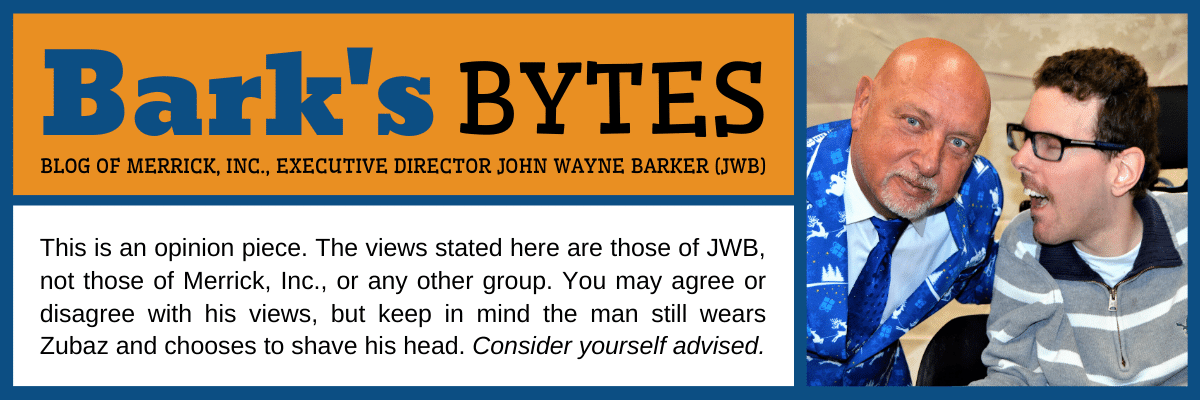Published November 9, 2021
In the wee hours of 6/26/21, without following parliamentary procedures and with no public testimony, language creating a taskforce to eliminate the 14(c) special minimum wage option in Minnesota by August 2025 was included in an omnibus bill later signed by the Governor. While the how and why that happened may be a topic for a future editorial, right now 6,000 people with disabilities and their families need to understand the consequence of this legislation.
[expander_maker id=”3″ more=”Read more” less=”Read less”]
There has been at least one article in Access Press by Andrea Zuber of Arc of MN celebrating this legislation and at least one television story on the topic. In the October 23rd KARE 11 story, Eva Anderson interviewed Brittanie Wilson, a disability advocate that works for the Minnesota Council on Disability and has applied to be on the taskforce. At the one-minute mark of the story, you hear Anderson mention a new taskforce that “aims to create a plan to make sure all people with disabilities are afforded that same right” (earn at least a minimum wage) followed by a statement from Wilson that it is “time for us to research, take our time, and make a plan that ensures no one is left behind.” I would concur that all people with disabilities should have the right to pursue making at least a minimum wage in the general workforce and time is needed to make sure that 6,000 people making an informed choice to earn a special minimum wage don’t lose that option. In that same story, Jillian Nelson from the Autism Society of MN is quoted as saying, “when we send a message that people with disabilities are worth the same as other employees, it’s going to improve employment outcomes for all people with disabilities, not just those in subminimum wage settings” and she could not be more wrong. In their March 2019 report “Success, Progress, and Struggle in Greater Minnesota,” the Mid-Minnesota Legal Aid (a federally designated protection and advocacy agency for MN) within the Minnesota Disability Law Center (MDLC) emphasized that “the most influential factor in creating this employment success was a high degree of person-centered focus within the DT&H facility.” Yet, they now support eliminating the special minimum wage option as an informed choice in a person-centered plan. How does that square up? Apparently, person-centered planning and informed choice only count to the MDLC when the outcome is the pursuit of employment in the general workforce making at least minimum wage.
In my view, Zuber, Nelson, and the MDLC subscribe to a belief that everyone is “the same” should be treated “the same” and have access to “the same” confusing equity for people in similar circumstances with reasonable accommodations for people in different circumstances. There was a related article in the New York Times entitled – “Helen Keller and the Problem of Inspirational Porn” (10/23/21) written by Leona Godin, an author with a sensory disability. This was followed by a letter-to-the-editor written by Carlisle Ford Runge, a distinguished McKnight Professor of Applied Economics and Law at the University of Minnesota and parent of a client at Merrick, Inc. His thoughts are as follows ~
“Leona Godin’s article is an important contribution. As parents of a disabled daughter (now 34) we have often found that the non-disabled seek the comfort of imagining the virtues of overcoming the many disadvantages the disabled and their caregivers face. Many of these disadvantages are simply physically or mentally impossible to overcome. One of the most pernicious and ultimately destructive ideas in current policy discussions is that all people, including the disabled, should be treated “the same”. This confuses the equity of treating similarly situated individuals in similar ways with the equity of treating differently situated individuals differently. These two forms of equity need to be balanced, so that unreasonable demands and expectations are not placed on the disabled. An example is the campaign in many states to eliminate lower-than-minimum wage allowances for disabled workers in places like supermarkets. The principal effect will be to eliminate opportunities for these individuals by forcing them to compete for the same jobs at the same wages with non-disabled workers. To put it starkly–does anyone really think that a paraplegic person can stock shelves at the same rate as a non-disabled person? Should this prevent the disabled worker from joining the workforce–albeit at an adjusted lower wage? Recognizing the differences of the disabled and making social and economic adjustments, rather than romanticizing their capacity to overcome their disabilities, is more fair, just and realistic.”
Recently the U.S. Commission on Civil Rights (CCR) issued its “Subminimum Wages: Impacts on the Civil Rights of People with Disabilities” 2020 Statutory Enforcement Report. Not only was it long at 349 pages and detailed with 1,320 footnotes; more than 9,700 public comments were submitted (far more than any other issue ever studied by the CCR). That four of the six Commissioners recommended elimination of 14(c) is another example of “Inspirational Porn” (refer to my Bytes editorial entitled “You”). Some of the more relevant dissenting comments included:
- “Generations ago it was more common for people to feel uncomfortable around the severely disabled. They wanted to keep disabled persons out of sight, because … well … disabled persons offended their sense of aesthetics. Today those who want to abolish sheltered workshops and Section 14(c) believe themselves to be a universe apart from those earlier generations. But they are the same. In both cases, it is all a matter of appearances … of what looks good. What is actually in the best interests of the disabled individuals doesn’t enter their minds.”
- “The report and its findings and recommendations take the tone throughout that although some people have not yet caught up with the caravan of progress and realized that competitive integrated employment is the wave of the future, the evidence favors the superiority of this approach. This is wrong. The Commission received far more public comments from parents of individuals who tried working in mainstream environments and did not thrive there. The “story after story” consists almost exclusively of a few people who testified at the Commission’s public hearing, a tiny smattering of parents whose children transitioned away from a sheltered workshop, and some people in Vermont, most of whom never worked in a sheltered workshop. It is not until page 99 that the report divulges that 98% of the public comments submitted to the Commission support the continuation of 14(c).”
- “It is also worth noting that the report found that employees with cognitive disabilities in Virginia and Arizona (which permit the payment of 14(c) wages) had the highest annual mean earnings every year since 2009. Vermont and Maine, which have ended 14(c), overall have the lowest annual mean earnings for employees with cognitive disabilities.”
Any decision regarding the special minimum wage should be based on the Minnesota Olmstead Plan approved by U.S. District Judge Frank. The current vision statement found on the Olmstead Implementation Office website states that “To get our vision, people with disabilities need choices about where to live, learn, and work. They need information about their choices and to understand their right to decide for themselves.” Where in this vision does it say we need to eliminate options or disregard informed choice? Getting back to Judge Frank’s ruling, he made some notable statements that I think support the protection of the special minimum wage option. These include:
- “In approving the revised Olmstead Plan, the Court also takes this opportunity to respond to those who have expressed fears about the plan’s purported harmful effects. The Court has received numerous submissions from concerned community members, parents, and advocates expressing fears that the Olmstead Plan will lead to fewer choices and diminished respect for individuals who choose not to fully integrate into community-based settings. Many individuals with disabilities in this state value living and working alongside other individuals with disabilities in settings such as group homes and sheltered workshops.”
- “The Court emphasizes that the Olmstead decision is not about forcing integration upon individuals who choose otherwise or who would not be appropriately served in community settings.”
- “The goal of placing individuals with disabilities in the most integrated setting must be balanced against what is appropriate and desirable for the individual.”
In response to the Levy Amicus Brief included in the ruling, then Commissioner Lucinda E. Jesson wrote a 3-page letter with a number of notable points that included:
- A statement that “…government and service providers begin listening to individuals about what is important to them in creating or maintaining a personally-valued community.”
- The term “productive employment” and not “competitive-integrated employment” was used when referencing the Plan’s vision statement, a term more consistent with individual choice, and “that people with disabilities should receive community-based services when the affected individual does not oppose it; segregated settings will be the preferred choice for some; and the Plan is not about eliminating certain service options or closing specific facilities.”
- Referenced a dispute resolution process for “individuals who believe that they have not received services or supports in accordance with the principles set forth in Olmstead v. L.C.” (page 537 of the dispute resolution process plan). In offering this “meaningful” protection the Commissioner essentially promised no harm to people with disabilities and the Court made a point of urging the State to “…remain vigilant to the public’s fears and concerns. Individual choice must remain a guiding factor in the delivery of community services and supports. The State must continue to assess its goals and priorities to ensure that they align with the goals and priorities of individuals with disabilities.”
Apparently, this balanced perspective on informed choice left DHS when Jesson did.
In 2016 it became a federal requirement that every person earning a special minimum wage go through an annual Career Counseling, Information and Referral (CCIR) session completed by the State Vocational Rehabilitation authority (DEED). The CCIR session includes the 14(c) wage worker, usually a family member, and an independent counselor (representatives from the day program are specifically excluded). In year five (2020 – 2021), DEED reports that 5,716 people earning a special minimum wage completed a CCIR session and 5,154 (90%) did not want a minimum wage job. Despite this fact, we are now on a course to eliminate the special minimum wage option for nearly 6,000 people with disabilities in Minnesota, who did not ask for this, merely for the appearance of “looking good.”
For the record, I believe that people with disabilities should have the right to work in the general workforce, at the same productivity level as their nondisabled coworkers, and be paid the same as their nondisabled coworkers; and that right should not eliminate the option for 6,000 other people with disabilities to earn a special minimum wage. There are many others that believe the same and are working hard to get this legislation repealed, or at the very least revised to make the purpose an objective study of employment services for people with disabilities in Minnesota. There is no harm in keeping the special minimum wage as one of the service options in Minnesota and to say otherwise is pernicious.
[/expander_maker]





